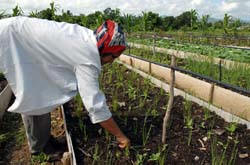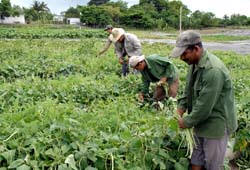 .
.
Urban Agriculture by no means dormant
Juan Varela Perez and Ortelio Gonzalez
Garden produce and fresh herbs gave a “cordial welcome” to the first
three months of the year, as though they wanted to prove that urban
agriculture is anything but dormant.
NOW IS THE TIME TO SOW SUMMER VEGETABLES.
FOTOS: ALBERTO BORREGA AVILA
The most important thing is not to have produced more than at the same
time last year, but for those on the ground to know that this movement
will not be halted by climatic setbacks.
The National Urban Agriculture Group (El Grupo Nacional de la
Agricultura Urbana), which is rigorous in its assessments, has just
confirmed this, at the end of one of its regular tours of the country.
BEANS, ONE OF THE CROPS MOST RECOMMENDED FOR THIS TIME OF YEAR.
All the provinces and the Special Municipality of Isla de la
Juventud (Island of Youth) received a good rating, although
Granma, Sancti Spiritus, Matanzas, Santiago de Cuba and Villa Clara did
better than the rest.
Doctor Adolfo Rodriguez Nodals, head of the Group, explained to
Granma that one of the most significant aspects of the season is the
increase in garden produce and fresh herbs and the fact that all regions
participated in the plan.
He also noted an improvement in the economic management of urban farms.
Of the 166 now up and running, a mere seven are not making a profit.
But, as long as there is even one unprofitable urban farm, we will not
be satisfied.
SEMIPROTECTED CULTIVATION
Most successful among the semi protected urban organic farms (organoponicos)
are those in Ciego de Avila, where 25 hectares, divided out in 48
allotments were prepared . This was achieved with the objective of
hosting International Workers’ Day (El Dia Internacional de los
Trabajadores), sometimes at the cost of working sixteen hours a day.
According to Doctor Rodriguez Nodals, next most successful among the
urban organic farms were those in Sancti Spiritus, Cienfuegos and Las
Tunas. However, Pinar del Rio, La Habana, Santiago de Cuba and
Guantanamo will need to intensify their efforts to create a system that
will generate vegetables and fresh herbs all year round.
Work is currently underway to complete 385 hectares of semi protected
urban organic farms this year, but the national plan is to continue
expanding.
Experience shows that, by rotating crops, each hectare can yield at
least 50 tons per semester in the initial stages, if regulations and
technical norms are observed during cultivation.
In all municipal areas a supply for social consumption in centres run by
the Ministry of Education and Public Health is seen as positive.
However, the supply of vegetables was less than plentiful in the
military units of the following eight municipalities which have links
with Urban Agriculture: Madruga and Jaruco (La Habana), Cotorro,
Guanabacoa, La Habana del Este and Plaza de la Revolucion (Havana City),
Santa Cruz del Sur (Camaguey) and Manuel Tames (Guantanamo).
At the same time, the assessors acknowledged an improvement in the case
of the Ministry of the Interior, since only the four following municipal
areas got this rating: San Miguel del Padron and Plaza de la Revolucion
(Havana city) , Santa Cruz del Sur (Camaguey) and Manuel Tames
(Guantanamo).
They also expressed satisfaction, with the state of the vast majority
of “productive backyards”, which are developed in close cooperation
with the Committees for the Defence of the Revolution (Comite de Defensa
de la Revolucion) . A similar situation was observed in the assignments
undertaken with the National Committee of Small Farmers (ANAP).
Productive activity with the Ministry of Sugar (MINAZ) was judged to be
average in Los Palacios (Pinar del Rio) and Melena del Sur (La
Habana). This institution is behind schedule in respect of its
investments in urban organic farms and intensive vegetable gardens,
with particular emphasis on the irrigation system and completion of
electrification.
However, the review highlights the achievement of MINAZ in planting
2,462 of those urban organic farms and, irrigating over 500 of these
through alternative methods.
Doctor Rodgiguez Nodals added that, while from an overall perspective
the balance is positive, not everything is going according to plan. In
32 municipal areas, there are problems hindering the fulfilment of
commitments made to the Basic Units of Cooperative Production (UBPC).
All the provinces have at least one such case, as does the Isla de la
Juventud. In two of the territories in Las Tunas and Guantanamo, namely
Majibacoa and San Antonio del Sur, there has been a decline in pig farms
where the animals were fed on local produce.
La Palma, (Pinar del Rio), Melena del Sur (La Habana) and Jaguey Grande
(Matanzas) received a rating of average, as municipal areas.
In this review, the 44th of its kind, a rating not exceeding
average was given to the following polytechnical institutes of
agriculture and livestock : Limonar (Matanzas), Abreus (Cienfuegos),
Camaguey , Majibacoa (Las Tunas) and Guama and Julio Antonio Mella
(Santiago de Cuba). They will need to correct their most serious
shortcoming, which is the poor quality of the productive teaching
modules.
La Habana, Holguin and Pinar del Rio got the same rating in respect of
their application of the technology of semi- protected cultivation.
The methods being used in the development of what is known as people’s
rice (arroz popular) and the encouraging news about those engaged
in the task of constantly improving both the quality and quantity of
vegetables and fresh herbs are positive signs.
This latest “tour of Cuba” by those who are the driving forces behind
urban agriculture provided an opportunity to focus on the question of
what should be done to eliminate idle or underused lands in the 10km
productive belts around provincial capitals and in Manzanillo. The
same applies to the areas around the municipal centres and all the
territories belonging to the city of Havana.
It was an ideal opportunity to study the needs of each crop or
livestock rearing subprogram, with reference to types of soil,
availability or otherwise of irrigation and the search for practical and
economical solutions aimed at perfecting cultivation in dry regions.
Those taking part in this review tour noted the availability of
vegetables on the market, but also pointed out the urgent need for a
radical change in crop structure to cope with the summer period. In
these months, when more heat resistant plants are needed, the
technical experts recommended increased planting of a range of
vegetables including beans, beet, Chinese chard, spinach, garlic and
cucumber.
This is to meet the challenge of offering substitutes for very tasty
fresh vegetables such as lettuce and tomato and lessening the
traditional summer deficit in high demand garden produce.
http://www.granma.cubaweb.cu/2009/05/11/nacional/artic01.html
|
| [http://www.granma.cubaweb.cu/2009/05/11/base.htm] |

 La
habichuela, entre los cultivos recomendables para estos
meses.
La
habichuela, entre los cultivos recomendables para estos
meses.